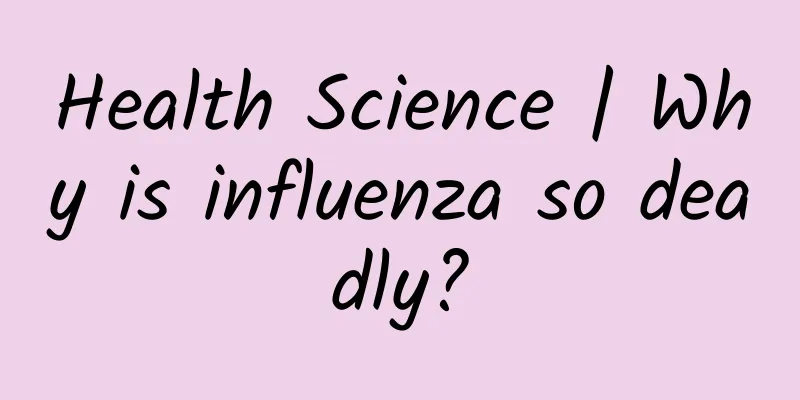Health Science | Why is influenza so deadly?

|
Winter and spring are the peak seasons for respiratory infectious diseases. Coupled with the Spring Festival holiday, the mobility of people increases significantly, and there are more activities such as dinners and parties, which increases the risk of contracting influenza. Why is the flu so deadly? Flu, also known as influenza, is an acute respiratory illness caused by influenza viruses. It usually presents with a sudden onset, accompanied by high fever, headache, muscle aches, fatigue, and mild respiratory discomfort. Although influenza will get better on its own in most cases, some patients may develop serious complications such as pneumonia, meningitis, and myocarditis. Historically, studies during influenza pandemics have shown that bacterial pneumonia is one of the most dangerous complications of influenza, and pneumococcus is the main culprit of this complication. At the same time, the presence of pneumococcus also helps the spread of influenza viruses and enhances their destructive power. Studies have also found that pneumococcal infection may aggravate influenza symptoms or cause secondary bacterial infections, making the virus more active, thereby expanding the scope of infection and aggravating the condition. Influenza generally presents with sudden onset of high fever, body aches, marked fatigue and mild respiratory symptoms. Although most cases are self-limited, some may develop into severe influenza with complications such as pneumonia. A few severe cases progress rapidly and may die from acute respiratory distress syndrome (ARDS) or multiple organ failure. Differences between influenza and the common cold Cold, flu, and mycoplasma pneumoniae infection all sound like cough and fever, but their harms are very different! Common colds generally have mild symptoms, usually heal on their own within 5-7 days, and have fewer complications. Influenza is highly contagious, and systemic symptoms are generally severe, which can easily cause complications such as pneumonia, encephalitis, and myocarditis. Mycoplasma pneumoniae infection has a slow onset, and the main symptoms include persistent, paroxysmal, severe cough, difficulty breathing, etc. After the symptoms appear, you can preliminarily analyze whether it is influenza or a common cold from the following aspects: Second, from the perspective of symptoms, influenza symptoms are more severe and the onset is rapid, often with a fever of more than 38.5°C , and in addition to coughing and sore throat, there are also obvious systemic symptoms, such as headache, muscle aches, and extreme fatigue , while the common cold is generally a low-grade or moderate fever, and some people may not have a fever. The main symptoms are nasal congestion, runny nose, and sneezing, and the symptoms are milder than influenza. Treatment recommendations for influenza After getting the flu, don't miss the "golden 48 hours". WHO recommends using antiviral drugs within 48 hours of the onset of symptoms. Healthy adults who suffer from influenza and have mild symptoms can use antipyretics, cough suppressants, etc. to relieve discomfort and ensure rest and hydration. If you have persistent high fever, muscle aches, severe symptoms that do not improve , especially those with severe tendencies and high-risk factors, you must seek medical attention in time. Under the guidance of a doctor, use antiviral drugs (such as mabaloxavir and oseltamivir) within 24-48 hours of onset. Some patients can still benefit from anti-influenza treatment if they develop symptoms for more than 48 hours . It is recommended to follow the doctor's advice. Do not abuse antibiotics . Severe patients may need to be hospitalized and receive oxygen therapy, respiratory support and other treatments. Remember not to take medication at will. In addition, there is often a period of low immune function after influenza. During this period, you need to pay attention to rest, avoid staying up late and overwork, so as to reduce the occurrence of complications such as myocarditis, pneumonia, and secondary bacterial and fungal infections. Influenza vaccination is the most effective means of preventing influenza . In particular, key groups such as children, the elderly, and medical personnel should receive influenza vaccination in a timely manner if there are no contraindications. Other common preventive measures for respiratory infectious diseases include: washing hands frequently, avoiding touching eyes (such as rubbing eyes), nose (such as picking nose) and mouth (such as picking teeth) with hands, and paying attention to coughing etiquette; keeping the environment ventilated. Homes, schools, workplaces, etc. can open windows regularly for ventilation, 2-3 times a day, each time for no less than 30 minutes; try to avoid crowded and enclosed places. If you are in crowded places or around people with flu-like symptoms, you should wear a mask that can prevent droplets (such as disposable medical masks), and the mask should cover both the nose and mouth. Experts remind that if someone in the family shows symptoms of acute respiratory infection, they can reduce the risk of transmission by wearing masks properly, collecting secretions in bags, washing hands frequently, reducing contact with public items, avoiding contact with the elderly and infants at home as much as possible, and ensuring environmental ventilation. |
>>: Here comes a guide to deal with "post-holiday syndrome"
Recommend
Breast health exercises
As women's breast problems become more and mo...
Does vasectomy have a big impact on women?
There are many ways of contraception, such as con...
Is oxygen good for the fetus?
The fetus also needs oxygen in the pregnant woman...
Asian scientists won this award for the first time! "Chinese solution" rewrites stroke treatment guidelines
The 2025 International Stroke Conference opened i...
A woman has a mole on her left shoulder blade
Although not everyone has a mole on their clavicl...
[Medical Q&A] Why do children still smile when they are depressed?
Author: Wu Meitong Guangzhou Women and Children&#...
A 20-year-old college boy got obsessed with playing "script-killing" and thought he was a character in the play, shouting in the middle of the night
Xiao Liu, a 20-year-old college boy, was rushed t...
What are the gynecological rapid hemostatic drugs?
In our daily life, many people have irregular men...
What is the ointment for vulvar itching?
Women often experience vulvar itching, which can ...
What to do if you have coccyx pain in late pregnancy
After a woman becomes pregnant, as the fetus grow...
At what age do girls start to grow hair?
It is normal for girls to grow pubic hair. Genera...
What is the cause of slight bleeding after sex?
A perfect sex life can make the relationship betw...
Why does a pregnant woman have dry mouth?
Everyone is familiar with the phenomenon of dry m...
Can explosive salt be put in the washing machine to wash clothes? Why is explosive salt not sold in supermarkets?
Explosive salt, commonly known as solid hydrogen ...




![[Lung Cancer Awareness Month] Exclusive interview with Professor Zhi Xiuyi - How to prevent and detect early lung cancer?](/upload/images/67f216f4903c4.webp)
![[Doctors Talk About Medicine] A complete guide to the prevention and treatment of coronary heart disease: From prevention to recovery, a one-stop guide](/upload/images/67f101b891358.webp)



